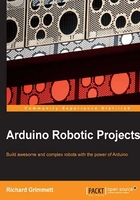
Conventions
In this book, you will find a number of styles of text that distinguish between different kinds of information. Here are some examples of these styles, and an explanation of their meaning.
Code words in text, database table names, folder names, filenames, file extensions, pathnames, dummy URLs, user input, and Twitter handles are shown as follows: "Arduino will then move to the loop() function and begin executing the statements there."
A block of code is set as follows:
// Pin D7 has an LED connected on FLORA.
// give it a name:
int led = 7;
// the setup routine runs once when you press RESET:
void setup() {
// initialize the digital pin as an output.
pinMode(led, OUTPUT);
}
// the loop routine runs over and over again forever:
void loop() {
digitalWrite(led, HIGH); // turn the LED on
delay(100); // wait for a second
digitalWrite(led, LOW); // turn the LED off
delay(1000); // wait for a second
}
New terms and important words are shown in bold. Words that you see on the screen, in menus or dialog boxes for example, appear in the text like this: "Select the TFTDisplayText example by navigating to Examples | TFT | Arduino | TFTDisplayText."
Note
Warnings or important notes appear in a box like this.
Tip
Tips and tricks appear like this.